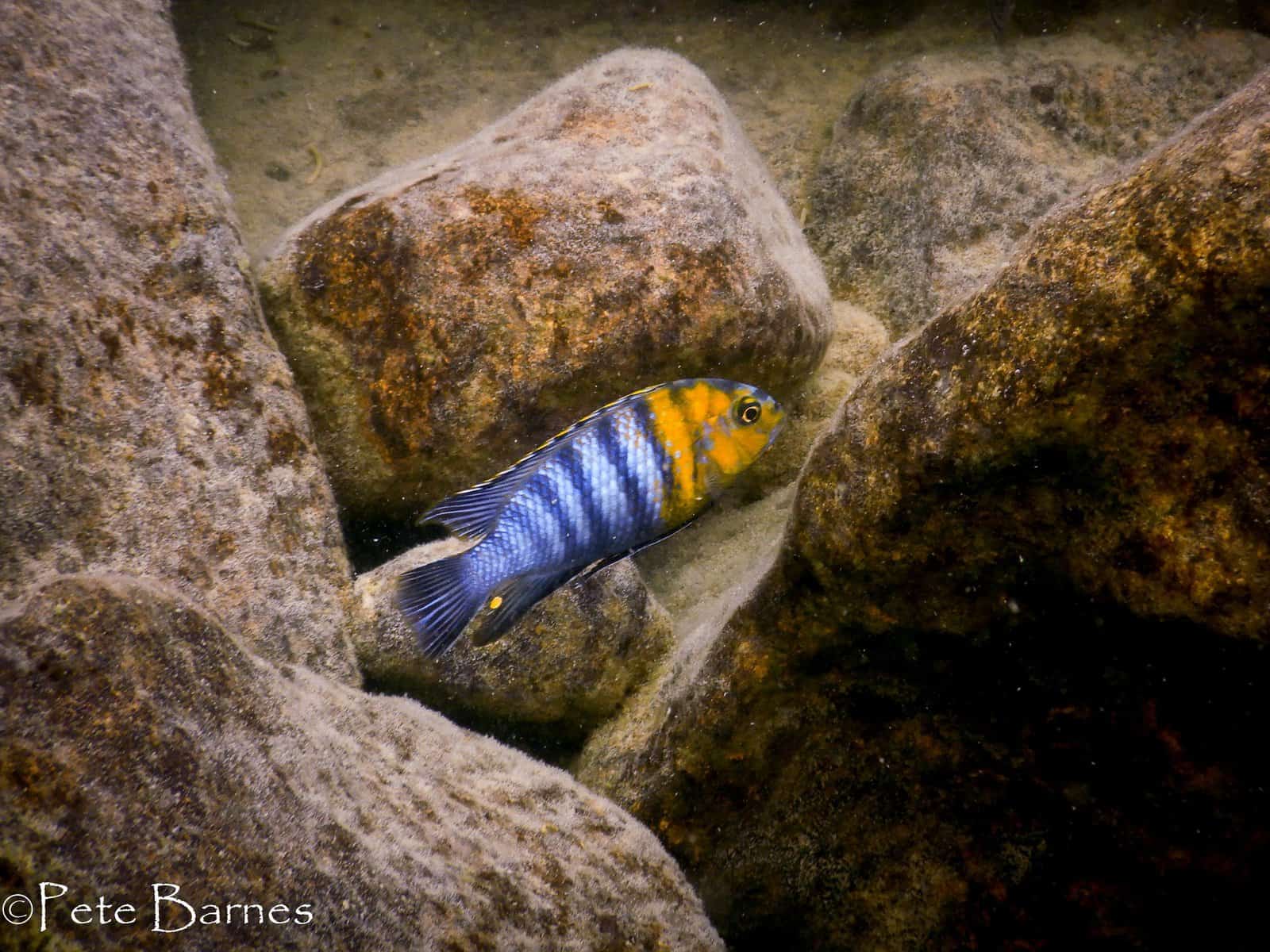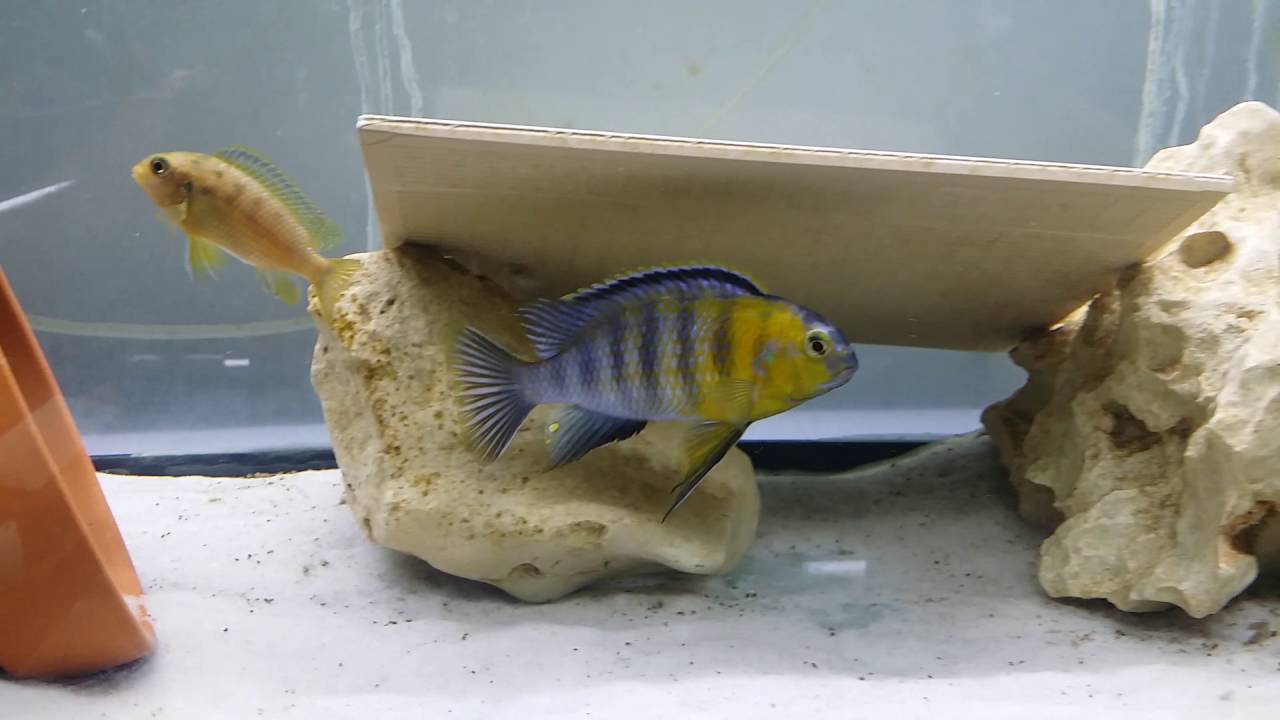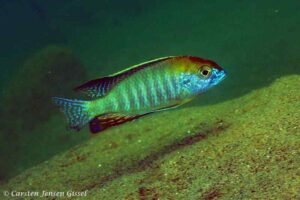Tropheops sp. ‘Red Cheek’
Tropheops sp. ‘Red Cheek’ is an undescribed species. The temporary name ‘Red Cheek’ refers to the color on the head and belly of the males of this species. That color is not really red but more ochre to rust colored. They have the somewhat understated mouth and style rising forehead of the other Tropheus species.
Description
Males of Tropheops sp. ‘Red Cheek’ can reach a length of about 11 centimeters in the wild. In the aqu arium they get a little bigger because we offer more and more vigorous food than they get in the wild . They have an ochre to rust colored head and belly. Black vertical stripes are visible on the flank .
The females look very much like those of Tropheops macrophthalmus. They are completely yellow/brown in color, including the fins. The females grow to about nine inches long in the lake. They also remain somewhat smaller than the males in the aquarium.
The character of this species can be described as fierce. The males do not tolerate other males of the same species in their territory.
Biotope
This species originates from the south of Lake Malawi. They are frequently caught at Likoma and Chizumulu. They occur on rocks with some current and waves. This leaves the rocks free of sediment. You can usually find them at depths from zero to six meters.
Diet
Tropheops sp. ‘Red Cheek’ feeds in Lake Malawi mainly by pecking into the strands of algae growing on the rocks (aufwuchs). In addition, they eat small amounts of plankton.
In the aquarium, it is not a picky eater. They take flakes, granulate, Daphnia, Brine Shrimp etc. Make sure you don’t give too much frozen or live food. Vegetable food should not be missing in the diet, spirulina flakes are an excellent addition.
The Aquarium
Due to its fierce nature and the fact that Tropheops sp. ‘Red Cheek’ forms a territory, we recommend an aquarium from 400 liters (about 150 centimeters in length). You can keep one male with two or more females in an aquarium of this size. That way the male will divide his attention between the females.
Keep them together with non-similar Mbuna species. A species too similar to Tropheops sp. ‘Red Cheek’ will cause fights between them.
Set up the aquarium with (filter) sand on the bottom. Place rocks in such a way that there are many holes, cracks and crevices. The male can build his territory here. Also, the females can hide from the male if he chases them too much to mate.
Water parameters
The water parameters in Lake Malawi are fairly equal and constant everywhere. The temperature may be between 22 and 26 degrees Celsius with a pH of 7.5 to 8.5.
Breeding Tropheops sp. Red Cheek
Breeding Tropheops sp. ‘Red Cheek’ as with most other Mbuna is fairly easy. In an aquarium with several species, they allow themselves to breed anyway. The male lures the female with trembling movements to his territory. While circling around each other , the female lays the eggs, which are fertilized by the male. The female then takes the eggs into her mouth. The eggs are incubated in her maw.
After about three days, the eggs hatch in the female’s mouth. However, she does release the young fish yet. They remain in the female’s mouth for a total of about three weeks from laying while feeding on their egg yolk sacks. The female does not eat at all during these three weeks. A brooding female can be recognized by the enlarged throat. Sometimes the dark spots of the young fish can be seen through the skin.
After three weeks, the young fish are released out by the female. The fish seek shelter between the rocks, but in an aquarium, with adult fish, they are often eaten.
Breeding Tank
If you want to keep more young fish you can set up a separate smaller breeding tank. Decorate it with some sand and some shelter for the female. Remover her from the aquarium after about 15 days and place her in the breeding tank. After the third week, she releases the young fish. She will not eat them immediately. You have enough time to catch the female after releasing the fry and put it back in the aquarium.
You can feed the young Tropheops sp. ‘Red Cheek’ with finely ground flake food and newly hatched artemia.
Video
Author
John de Lange
Copyright images
Mark Thomas – Marks Fiskenarie
Pete Barnes
References
Malawicichliden in hun natuurlijke omgeving – 3e oplage – Ad Konings – pagina 30-32
Back to Nature Gids voor Malawi Cichliden – Ad Konings – pagina 182-183
Cichlideae.com












